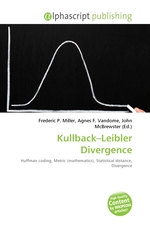Kullback–Leibler Divergence
Frederic P. Miller, Agnes F. Vandome, John McBrewster
бумажная книга
High Quality Content by WIKIPEDIA articles! In probability theory and information theory, the Kullback–Leibler divergenc (also information divergence, information gain, relative entropy, or KLIC) is a non-symmetric measure of the difference between two probability distributions P and Q. KL measures the expected number of extra bits required to code samples from P when using a code based on Q, rather than using a code based on P. Typically P represents the "true" distribution of data, observations, or a precise calculated theoretical distribution. The measure Q typically represents a theory, model, description, or approximation of P. Although it is often intuited as a distance metric, the KL divergence is not a true metric – for example, the KL from P to Q is not necessarily the same as the KL from Q to P. KL divergence is a special case of a broader class of divergences called f-divergences. Originally introduced by Solomon Kullback and Richard Leibler in 1951 as the directed divergence between two distributions, it is not the same as a divergence in calculus. However, the KL divergence can be derived from the Bregman divergence.
Данное издание не является оригинальным. Книга печатается по технологии принт-он-деманд после получения заказа.


